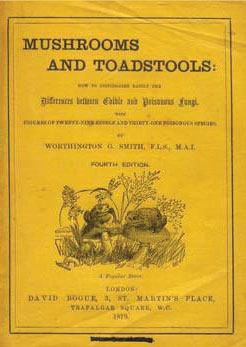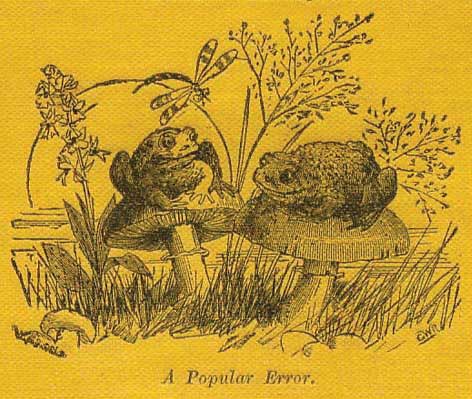Case Studies
Toadstools
The above illustrations show the cover (and enlarged detail) of the 4th edition of Worthington G Smith's Mushrooms and Toadstools: How to distinguish easily the differences between the Edible and Poisonous Fungi, published in 1879 by David Bogue, London. This book of 64 pages is a simple guide to some common species and the book's linen cover is about 12.5 centimetres across and 17 centimetres in height. The cover drawing is by the author.
The following extract gives the author's thoughts about men who poison themselves with mushrooms:
Although the following statement may be difficult to understand, it is nevertheless a fact that many men do not know what a mushroom is at all, but will eat anything. I will give an instance: A year or two ago, a man in the north of England cooked a large batch of what he called mushrooms, for supper, and succeeded in poisoning his wife and family to death, and himself nearly to death. Some of the things he cooked were sent to me for identification, and lo! he had gathered everything he could lay his hands upon; large and small, sweet and foul - off horsedung, and rotten palings, and from wherever he could find anything with a stalk and a top to it after the manner of an umbrella. When he had buried his family and recovered his own health, he carelessly walked into a well and either killed himself or much damaged himself - I forget which. I mention this to show the sort of men they are who poison themselves with mushrooms. They would poison themselves with anything else if they had the opportunity; would get under a cart-wheel, or do any absurd thing.
In 1953 the British mycologist John Ramsbottom included four toad-and-fungus photographs in his book Mushrooms & Toadstools: A Study of the Activities of Fungi. The book went through several printings and is fairly easy to find. Indeed, perhaps you own a copy. The photos showed (1) a toad at the base of a bolete; (2) the toad stretched out, two back feet on the ground and one front foot on the bolete's cap; (3) the toad almost totally on the bolete cap, with just one back leg dangling and (4) the toad totally on the cap. Ramsbottom acknowledged The Times newspaper as the source of the photos. In the book listed below the Wassons commented about the widespread fascination with a toad-toadstool connection:
Not infrequently commercial artists and fanciful illustrators of children's books represent toads with toadstools, and occasionally even photographers contrive by trickery to juxtapose the two. In every such instance they draw their inspiration from the word, not from nature.
In a footnote on the same page they added:
Thus on Nov. 8 1930, The Times published a sequence of six photographs showing a toad as it approached a bolete, clambered up on the cap, and finally sat there. Dr. John Ramsbottom reprinted four of these in his Mushrooms & Toadstools, Collins, London, 1953, facing p. 287. The photographer, Neville Kingston, died in the 1930s. The Times kindly supplied us with his original series of seven photographs, and by internal evidence it is clear that they do not record a spontaneous happening in nature. Innocent and playful in intent, and delightful as one more example of man's underlying loyalty to cherished error, these photographs must be docketed as nature fakes. Toads when slightly chilled become lethargic and lend themselves to posing, a secret undoubtedly known to Kingston.
Reference
Wasson, VP &Wasson, RG. (1957). Mushrooms, Russia and History, Volume 1. Pantheon Books, New York. [The comments are on page 65.]
|
![An Australian Government Initiative [logo]](/images/austgovt_brown_90px.gif)



